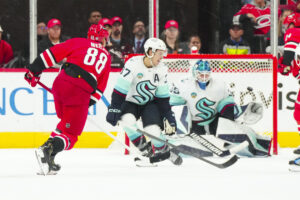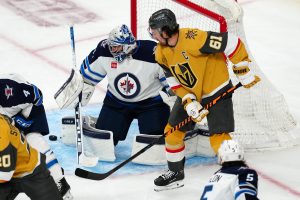NHL Player development seems to always result in more questions than answers. How likely is it for a top pick to pan out? What makes a player a “steal”? Last Word On Hockey’s latest series takes a look at how to properly develop prospects from all different spots throughout the draft. This week’s piece involves top-10 picks and how they were used early in their careers.
NHL Player Developments of Top 10 Picks
In the span of 2005 through 2015, there were 40 total selections made between fourth overall and tenth overall on forwards playing in North America. Of those 40 selections, four players were given immediate NHL roles, despite being well-behind close to NHL-ready. For those not sure what those categories entail, take a look at my prior piece detailing the development of top three picks. The four players we’ll be looking at in this series are Alex Burmistrov, Jeff Skinner, Josh Bailey and Evander Kane. In this piece, we will look at the development of Josh Bailey and Evander Kane.
NHL Player Development of Josh Bailey
Josh Bailey, drafted ninth overall in the 2008 NHL draft by the New York Islanders, was given an immediate NHL role after a season with the OHL’s Windsor Spitfires. In his draft-year+1 season, Bailey split his year between the Spitfires and the Owen Sound Attack, scoring 61 points in 69 games combined between the two teams. That was good enough for a 0.884 points per game pace, ranking 23rd out of 40 D+1 forwards. In his DY, Bailey played 67 games with Windsor, scoring 29 goals and 67 assists for 96 points in 67 games, recording a 1.433 points per game pace. That ranked 13th out of 40 forwards for DY production.
How Was Bailey Used?
In his rookie season following a year in the OHL, Bailey would record seven goals and 18 assists for 25 points in 68 games played. He did that while averaging 15:29 time on ice per game. Analytically, Bailey recorded a 2.1 Even Strength Goals Above Offensive (EVO) and a -1.2 Even STrength Goals Above Defense (EVD). On top of that, Bailey had a Wins Above Replacement (WAR) ratio of 0.3 and a Goals Above Replacement (GAR of 1.9). Ultimately, Bailey was decent as a rookie, but nothing to write home about.
In his second pro season, Bailey would play 73 games, averaging a similar 15:09 time on ice per game, likely due to his difficulties transitioning to the NHL as a rookie. He would score 16 goals and 19 assists for 35 points this time, a marked improvement from the previous season. His analytics were also much improved, with his EVO, WAR and GAR jumping up to 6.7, 1.3 and 7.4 scores, respectively. Bailey’s EVD would drop slightly to -1.9.
Bailey Struggled in New Role
As for his third season, Bailey was rewarded for his improved play, averaging 17:50 ice time per game, up over two minutes on average over the previous seasons. However, he did not prove to be ready for that role, recording 11 goals and 17 assists for 28 points in the 70 games he played. In fact, he even saw an 11-game stint in the AHL, recording six goals and 11 assists for 17 points.
Bailey’s analytics showcase a marketed decline from year two into year three. Bailey saw a steep drop in his EVO, WAR and GAR scores (0.2, -0.3, -1.6). Meanwhile his Even Strength Value on Defence (EVD) EVD continued to fall year-to-year (-3.4). Year three proved to be too much for Bailey to handle, and his ice time fell back down to 15:13 in his fourth year. While Bailey was a late bloomer, not truly breaking out until his ninth NHL season, he remained a middle-six option for the Islanders, a consistently safe bet to record 40 or more points a year. The Islanders casual and relatively slow player development of Bailey paid off. He may not have become an elite point producer, but he is extremely valuable to the organization.
NHL Player Development of Evander Kane
Evander Kane was drafted fourth overall in the 2009 NHL draft by the Atlanta Thrashers. He had just completed two full seasons in the WHL with the Vancouver Giants and was then handed an immediate NHL role. In his DY-1 season, Kane produced 24 goals and 17 assists for 41 points in 65 games for a points-per-game rate of 0.631. That per-game rate ranked 32nd out of 40 forwards in DY-1 production.
In his draft year, Ksne scored 48 goals and 48 assists for 96 points in 61 games with the Giants. That is a per-game rate of 1.574 points. That rate landed him in ninth out of 40 forwards in DY production. Because of a one-year sample of well-above-average per game stats, Kane was deemed not NHL-ready by many insiders. The Thrashers did not care and gave him an immediate role anyways.
How Was Kane Used?
In his rookie season, Kane would play 66 games with Atlanta. He scored 14 goals and 12 assists for 26 points, finishing in the top-10 for Calder trophy votes. Kane did this while averaging 14:00 of ice time per game. On the analytical end, Kane recorded a 7.7 EVO, -4.1 EVD, 0.8 WAR and 4.2 GAR. Essentially, Kane was a very good even-strength offensive player, but struggled immensely when it came to defensive zone play.
In his second season, Kane would see a raise in his ice time to 17:52 per game, on average. He also played 73 games, seven more than the year prior. With more games played and an increased role, Kane scored 19 goals and 24 assists for 43 points. That’s a sizeable step up from his rookie campaign. Analytically, Kane would remain a solid offensive contributor (7.6 EVO). He would also take a leap forward in his defensive game (-0.9 EVD). Because he maintained his offense and improved his defense, his WAR (1.9) and GAR (10.7) both improved by quite a bit.
Great Player Development Continues in Year Three
Despite having a much improved defensive performance, it seemed the newly-relocated Winnipeg Jets preferred Kane’s offensive output above all else. He averaged a similar time on ice as year two in his third campaign. Playing in 74 games, Kane averaged 17:31 time on ice per game. He wound up scoring 30 goals and 27 assists for 57 points. That is yet another step forward in production. Analytically, he would improve in every way possible. His defense, though it wasn’t by much, improved to a -0.4 EVD score. Meanwhile, his EVO jumped up to an impressive 12.8 in year three. Because of his continued improvements in defensive zone abilities and a big step in his offensive abilities, Kane saw his WAR stock rise even more (3.4) and his GAR skyrocketed (19.7). All-in-all, the then-20 year old Kane was developing exactly the way the Jets had hoped.
Moving forward, Kane would average over 19 minutes per game the next three years. That’s including two seasons of over 20 minutes per game. He would then leave for the Buffalo Sabres, where his production dipped. Kane was then traded in his third season with the Sabres to the San Jose Sharks. There, he would maintain a first-line role and watch his production return to his 50+ points per season form. The player development of Kane by the Thrashers/Jets carved him into a very good player.
Where Are They Now?
Josh Bailey came into the league averaging middle-six minutes and maintained that role the whole way through. His production would greatly improve. In the last four seasons, he has produced 71, 56, 43 and 35 points, with the last two seasons being shortened. Bailey is a leader on and off the ice for the Islanders, and his offense really comes out in the playoffs. He’s scored eight goals and 25 assists for 33 points over his last 41 playoff games while donning the “A” on his Islanders jersey.
Evander Kane was developed extremely well by the Thrashers. They eased him into his rookie season, giving him 14 minutes a night. He stuck and proved he was an NHL player. They gave him a raise in ice time, and he took that opportunity to the moon. Kane really began hitting his stride towards the end of his Jets tenure. He could’ve been a really good player if he hadn’t hit a wall in Buffalo. Eventually, Kane was set free to San Jose, where they also acquired the then-elite defenseman, Erik Karlsson, in hopes to chase a Stanley Cup.
Kane’s Difficult Sharks Tenure
Sadly, it did not end up that way, as the Sharks are now a basement-dweller in the league. Kane’s production certainly has not taken a hit by any means. But character concerns that were had before joining the Sharks were amplified. Between going through bankruptcy and accusations of gambling on his own games, Kane’s time with the Sharks could be over if he does not get his act together. All in all, however, Kane’s player development went exactly how it needed to. He was eased into a role in year one, then was given a bigger role in year two. In his third year, he maintained that same role and continued to take a step forward.
*EVO: Even-Strength Offense Goals Above Replacement
*EVD: Even-Strength Defense Goals Above Replacement
*WAR: Wins Above Replacement
*GAR: Goals Above Replacement
Junior league stats via Elite Prospects, NHL stats via Hockey Reference, NHL analytics via Evolving Hockey
Main Photo: Embed from Getty Images






